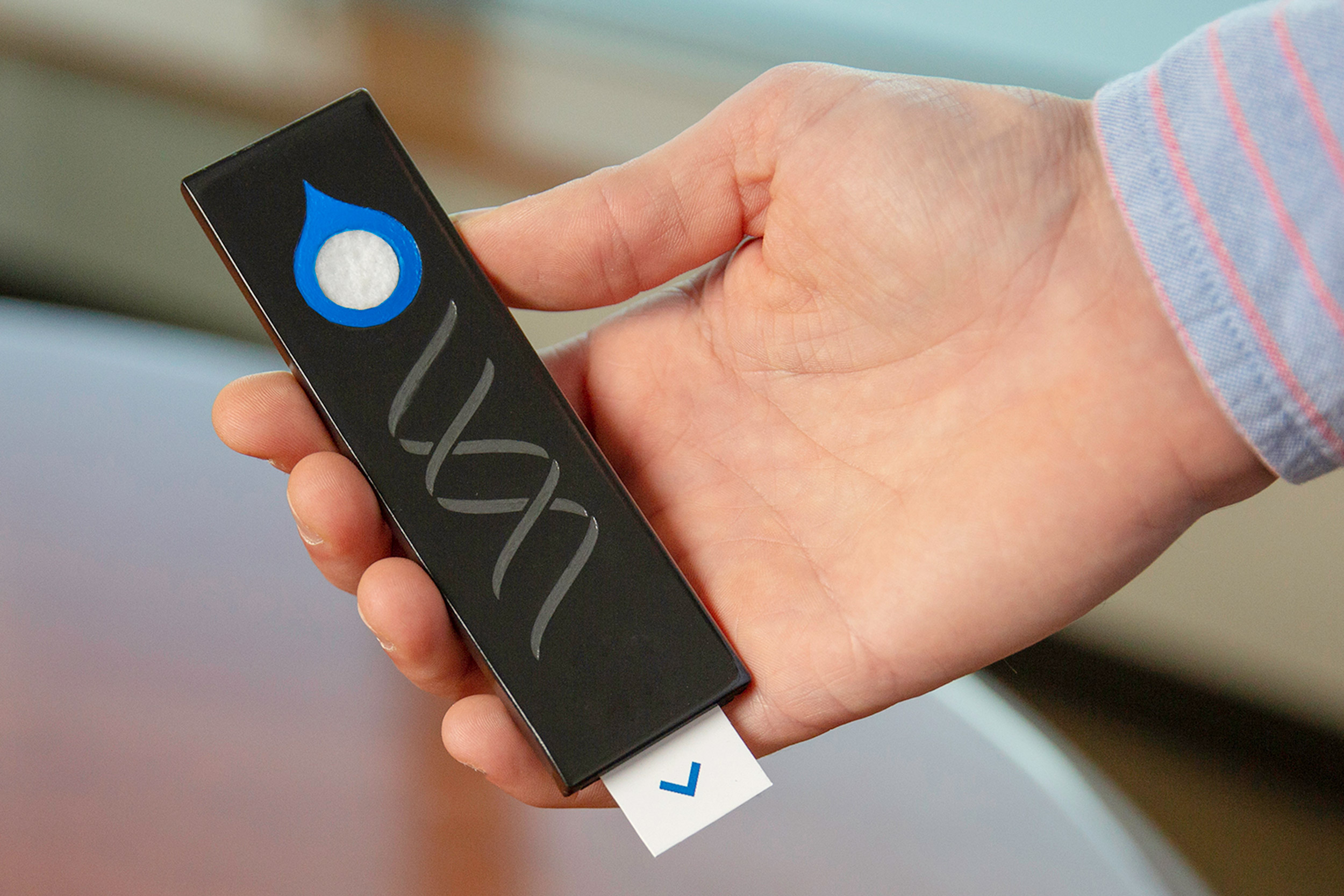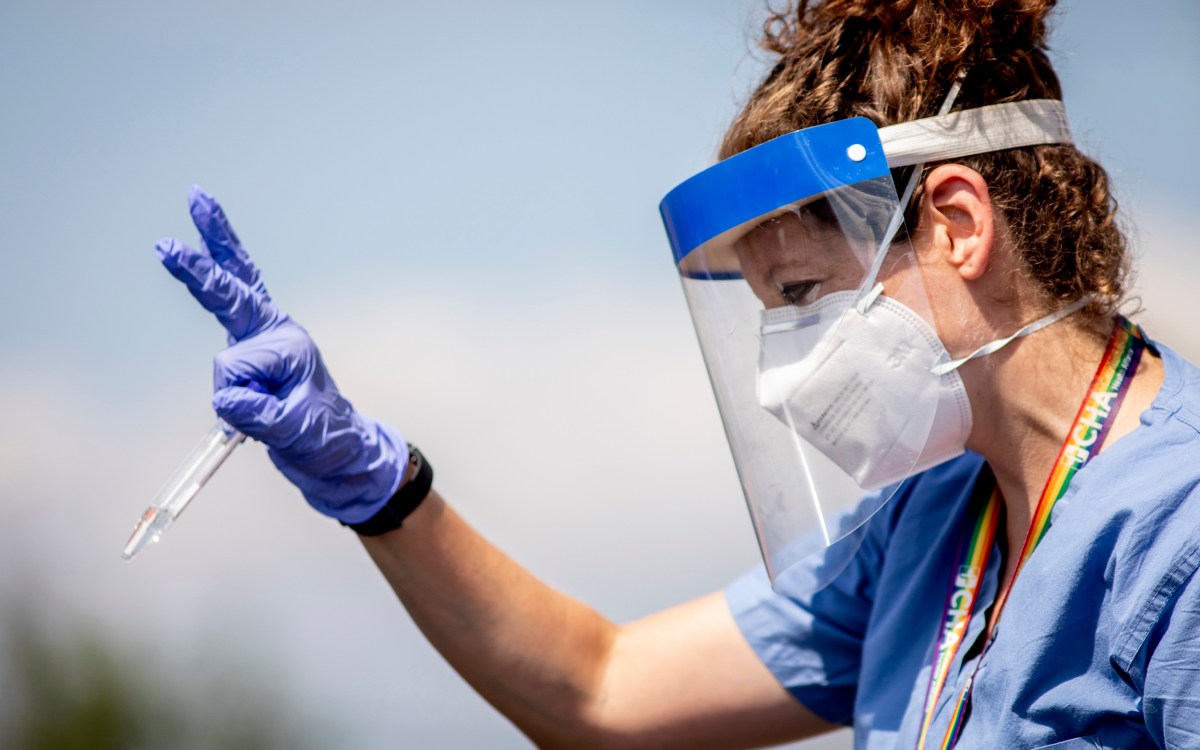
A paper-based COVID-19 test developed at Harvard’s Wyss Institute for Biologically Inspired Engineering.
Photo courtesy of the Wyss Institute at Harvard University
Cheap, frequent COVID tests could be ‘akin to vaccine,’ professor says
Chan School’s Michael Mina urges federal regulatory approval, widespread use
A Harvard epidemiologist and expert in disease testing is calling for a shift in strategy toward a cheap, daily, do-it-yourself test that he says can be as effective as a vaccine at interrupting coronavirus transmission — and is currently the only viable option for a quick return to an approximation of normal life.
“These are our hope,” said Michal Mina, assistant professor of epidemiology at Harvard T.H. Chan School of Public Health and Brigham and Women’s Hospital. “We don’t have anything tomorrow, other than shutting down the economy and keeping schools closed.”
As the pandemic’s health, economic, and educational toll mounts, Mina, a member of the Harvard Chan School’s Center for Communicable Disease Dynamics, said the paper-strip tests have already been developed and their shotgun approach to testing — cheap and widespread — provides a way back to the workplace, classroom, and other venues.
The strategy, if adopted and backed by the federal government, could put hundreds of millions of tests in the hands of consumers within weeks, at a cost far less than repeated rounds of economic stimulus, Mina said. The tests, which can be produced for less than a dollar, can be performed by consumers each day or every other day. Though not as accurate as current diagnostic tests, they are nonetheless effective at detecting virus when a person is most infectious, Mina said. If everyone who tests positive stays home, he said, the widespread effect would be similar to that of a vaccine, breaking transmission chains across the country.

“They can effectively be akin to a vaccine that was introduced tomorrow,” Mina said, speaking to reporters on a conference call on Friday. “We keep trying to use these diagnostic tools that just tell us what’s going on [with an individual] once every couple of months when they may be tested. It’s doing nothing to stop transmission chains.”
The current test-and-trace strategy, which uses a high-accuracy, laboratory-processed test, is well-suited for detecting individual infections as a prelude to medical treatment. But its high cost and slow turnaround time make it ineffective for the broader goal of curbing transmission in the community. Mina estimated that the nation’s current testing strategy probably catches less than 3 percent of cases early enough to affect whether a person transmits the virus. But as long as those testing positive stay home, a cheap, at-home testing regimen has the potential to provide a kind of artificial herd immunity, interrupting enough transmission nationwide to cause the pandemic to stall.
“What I would like to see happen is to start using testing [as] a true public health tool to break transmission chains in the same way that we know we can use masks to decrease transmission,” Mina said. “I want these tests to tell people they’re transmitting [the virus to others] at the time they’re transmitting, and [when] people can act on it because they’re getting immediate results. And I want them to take it every single day, or every other day.”
Several companies have developed such tests, Mina said. Two are small, Sherlock Biosciences — whose paper-based test was developed at Harvard’s Wyss Institute for Biologically Inspired Engineering — and E25 Bio, which has roots at MIT and Harvard, while a third is Minnesota-based multinational 3M, which has been working with MIT researchers to develop an inexpensive paper-based test that the company describes as being similar to at-home pregnancy tests.
“[The testing method] will stop the vast majority of transmission and it will cause these outbreaks to disappear in a matter of weeks.”
Michael Mina
Several hurdles stand in the way for widespread dissemination of the tests, Mina said. Perhaps the largest hurdle is regulatory. The Food and Drug Administration, in charge of approving diagnostic tests, has held up approval because the tests aren’t as accurate as nasal-swab, lab-based tests. While that would matter if they were intended as an individual diagnostic tool, Mina said that from a public health viewpoint, they are accurate enough to provide critical initial screening on a large scale. Positive test results could be followed up by a visit to the doctor and a more accurate nasal swab test or, if illness weren’t that severe, by daily testing until a person is negative.
“Everyone says, ‘Why aren’t you doing this already?’ My answer is, ‘It is illegal to do this right now,’” Mina said. “Until the regulatory landscape changes, those companies have no reason to bring a product to market.”
Mina said he’s concerned that approval will be contingent on making the tests closer to the accuracy of PCR (polymerase chain reaction) tests, which will likely add enough cost to short-circuit their widespread use, and their usefulness as a vehicle to interrupt the course of the pandemic.
The second hurdle is resources. Since most of the companies developing these tests are small, Mina said FDA approval would mean production could begin soon, but only on the scale of millions of tests per week — well below the level needed to test a nation of 330 million daily or several times per week. What’s needed, he said, is the federal government’s financial and organizational clout to both provide resources and get companies working together. Though even a $1 per day test gets expensive if the federal government provides them free to all Americans, the cost would be far less than recent stimulus efforts, and even less than the effort to produce a vaccine, the urgency of whose development would ease if the testing regimen is effective.
“It will stop the vast majority of transmission and it will cause these outbreaks to disappear in a matter of weeks,” Mina said. “This is something we can actually do at warp speed.”









